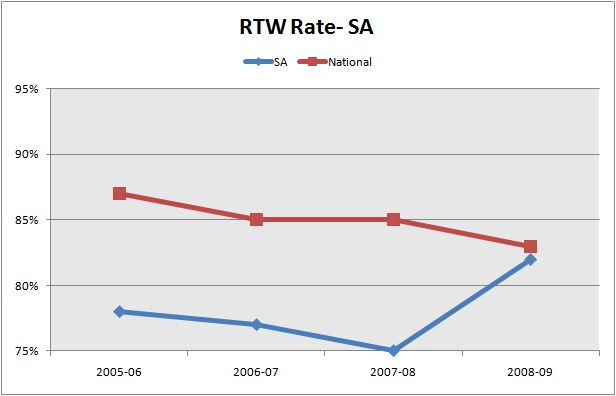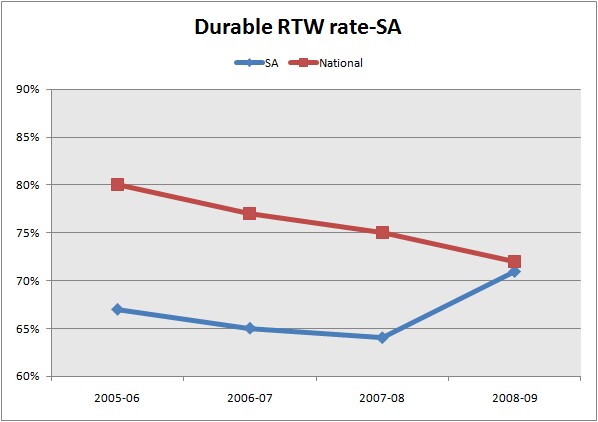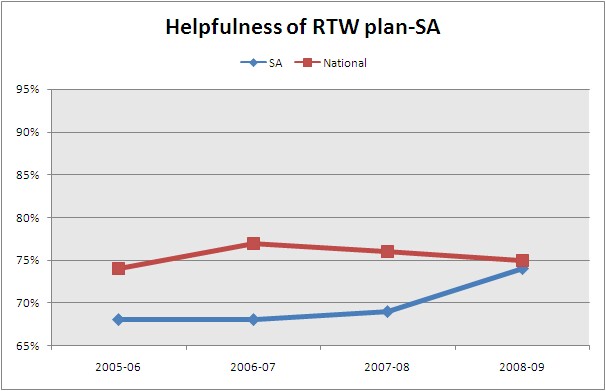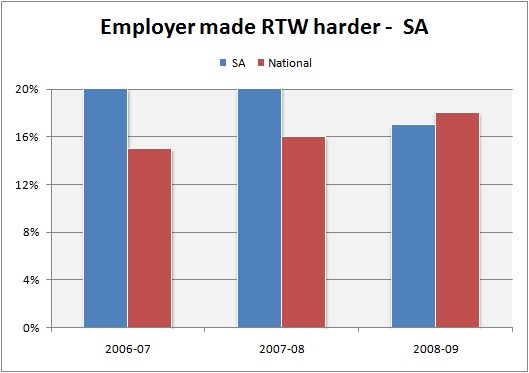South Australia heads north

In recent years workers' compensation South Australia has been considered the ‘basket case’ of Australia. The average premium paid in South Australia is high, unfunded liabilities have been huge and growing, and return to work rates have been well below the Australian average.
There appears to have been a turnaround.
When the costs of a workers' comp scheme blow out a financial turnaround is often achieved by simply moving the long-term and most expensive claims off the system.
SA’s recent annual report shows their financial position is improving. It appears to have been achieved via better investment performance, and by moving claimants off the system.
There are sound medical reasons for preventing long-term dependence on a compensation system, however, to simply move people off the system is not a way to improve health outcomes.
Not managing return to work well entrenches people in long-term disability, to then simply 'move them on' from the system is socially irresponsible. Yet this is approach has commonly been taken by Australian jurisdictions to get out of financial difficulty.
So what is WorkCover SA doing about the problem?
Last week we published our analysis of the SA results from the RTW Monitor. The bright side is what is happening with returning people to work.
Return to work rates have improved significantly.
In 2007-08 the overall return to work rate was 75%. In the last 12 months this increased to 82%. The durable RTW rate, a measure of more sustained return to work, has increased from 64% to 71% over the same period. Another measure of return to work is the number of days of compensation paid for the average case; this has reduced from 80 to just under 70 days in the last 12 months. This means the average person is back at work earlier or for more sustained periods.
 |  |
How have these improvements in RTW been achieved?
As we recently discussed, there is a correlation between return to work results and whether an employee considers they have been helped or hindered in their efforts to return to work. The most common obstacle reported to be a hindrance to return to work is the workplace.
The graph below, from a recent presentation by Campbell Research and Consulting, demonstrates that RTW outcomes clearly correlate with whether the worker considers the employer to be helpful.
Doctors, by the way, were seen to be helpful by workers whether the outcome was a durable RTW, non durable, or no RTW was achieved.
But the rating of the employer and in particular the main supervisor has a clear impact on the RTW outcome. When the employer was rated as helpful, a durable RTW was more likely. Similar results were noted for the main supervisor's helpfulness rating.
.jpg)
The proportion of employees with an injury who received a return to work plan in South Australia has always been higher than the national average. However, during the last 12 months there has been a significant increase in the percentage of employees reporting that they find this plan helpful.
 |  |
More importantly, the percentage of employees with an injury who report their employer makes it harder to return to work has fallen. For the first time since the RTW Monitor began recording this information the SA rate is now below the national average.

The percentage of employees who report their main supervisor made it harder to return to work in SA still remains higher than the national average and has not altered significantly over the last 12 months. We are aware that South Australia is currently looking at ways it can provide supervisor training.
If workers are finding more help and less hindrance from their employers in South Australia, how has this come about?
To start with there has been legislative change. This was the cause of much angst when it was introduced. Employers with over 30 employees are now required to have a Rehabilitation and RTW Coordinator, bringing SA workplaces into line with many other states.
WorkCover in South Australia has taken a positive approach to supporting these new coordinators. Mid year they ran a major conference, inviting excellent speakers with strong credentials to talk about positive ways of improving return to work.
Training programs have been set up. In addition SA has developed a forum, where coordinators can discuss issues among themselves, seek and offer advice, build peer networks, and provide feedback on the system. And WorkCover is acting on the feedback from the forum. In the past this kind of open democratic approach has been avoided by other authorities, fearful of what might occur if control slipped.
SA's approach is to build a partnership model, rather than a telling or authoritarian model.
When the lead organisation in a system examples the behaviours that underpin successful return to work, those behaviours are more likely to occur at the workplace. This appears to be what is happening in South Australia and those involved deserve both support and congratulations.
The South Australian model of supporting return to work coordinators in a partnership approach is to be applauded. In addition to advising coordinators on system structure and operation, the team at WorkCover SA ask coordinators what they need, how they can be helped, and WorkCover SA is acting on the feedback!
If this approach of assisting and supporting flows through to the employee, the benefits could be huge.

